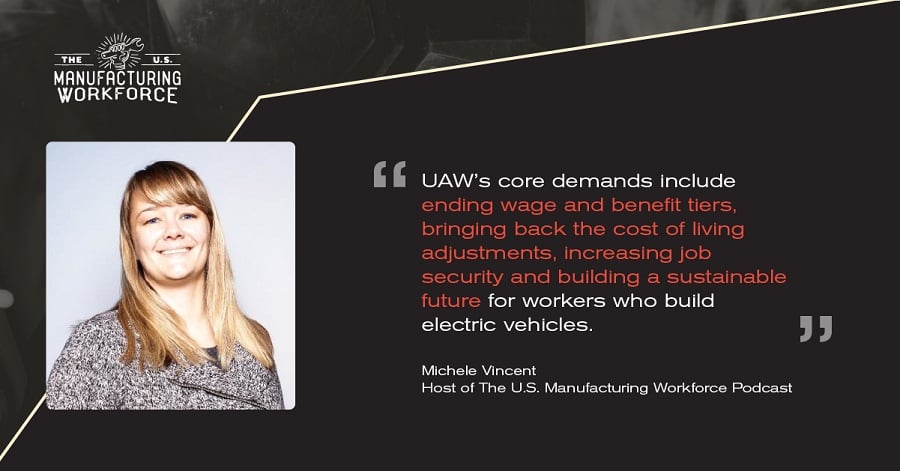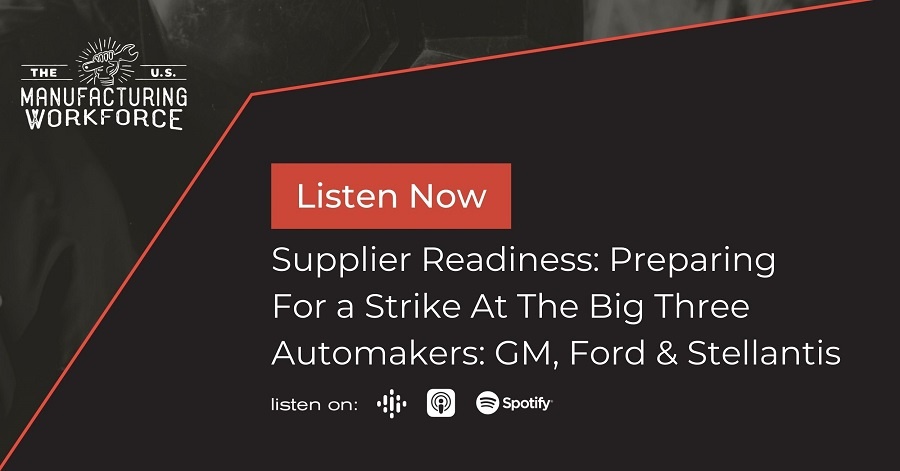Negotiations between the United Auto Workers, Stellantis, Ford, and General Motors started on July 14th. Their collective bargaining agreements all expire September 14th and cover a combined 150,000 union members throughout the United States. Stellantis has 43,000 union members, Ford has 57,000 and General Motors has 46,000. In this episode, we dig into some labor history and set the stage about what’s going on now, what to expect moving forward, and the potential for a strike.
2019 UAW Strike Against General Motors
Back in 2019, the UAW went on strike against General Motors for 40 days and it’s estimated that it cost the company around $3.6 billion dollars. The walkout consisted of 48,000 union members from about 50 GM facilities across the country. It did not just impact GM, but it trickled down and impacted suppliers as well. It was estimated by the Original Equipment Suppliers Association, a trade group for auto suppliers, that more than 100 of GM’s suppliers enacted some form of temporary layoffs impacting approximately 12,000 salaried and hourly employees as a result of the work stoppage. In addition, the Teamsters International union stood in solidarity with strike UAW members and honored their picket lines by refusing to deliver GM cars during the strike.
UAW: Turmoil, New President & Mission
Since then the UAW union has also had turmoil within its membership and it's been in the headlines quite a bit over the past several years due to a federal investigation into leadership corruption involving bribery, embezzlement, and other crimes resulting in 16 convictions including two former UAW Presidents. Fast forward to now -- the UAW now has a new international President, Shawn Fain, who was sworn in just this past March and that’s important to note because new union leadership whether at the local or international level always injects a little more uncertainty and risk for negotiations. New union leaders have something to prove to their membership and employers don’t know what to expect during negotiations. Shawn is looking to reunite his membership, post-corruption issues, and has stated that the UAW is ready to fight back – in fact, he said that’s not a threat, but a promise.
That said, there tends to be a lot of theatrics during union negotiations which are always interesting to watch, especially for large ones like these that capture national news attention, and these negotiations are no different. Shawn is already taking a tough stance with Automakers and believes this contract fight will be a defining moment as the auto industry transitions to electric vehicles and he has stated that the union will not accept any concessions. He’s setting the stage for organized labor to win a war against corporate greed and multi-billion dollar corporations. Their core union demands include:
- Ending wage and benefit tiers that divide workers
- Bringing back Cost of Living Adjustments (COLA)
- Job security when companies are making record profits
- Building a sustainable future for workers who build electric vehicles
In a Facebook Live appearance to address members, Shawn Fain said the union is in a strong position to make major gains in talks with Stellantis, Ford and General Motors, “but only if our members get organized and are ready to strike.”
He also said whether there are strikes depends on how the companies react, and that the automakers have made billions in the past 10 years but haven't rewarded workers. He said they have to be able to do whatever they have to do if they want to these gains because the companies aren’t going to freely hand them over.
Transition To Electric Vehicle & Joint-Venture Battery Production
The transition over to electric vehicles is having a huge impact on the industry and that will certainly impact negotiations. I talk about this in a previous podcast episode Revving Forward: The 24 Essential Supply Chain Processes – where I spoke with Cathy Fisher and Terry Onica who share a combined 70 years of automotive industry experience. As far as the EV transition specifically -- Fain is unhappy with Stellantis’ move to close a factory in Belvidere, Illinois – because they placed the Jeep plant on “idle” in February and laid off most of its 1300 workers.
Stellantis, GM, and Ford have also all announced plans to build multiple joint-venture battery factories in the U.S., but only GM thus far has recognized the union to bargain for those workers. So obviously the union is looking to ensure they can organize workers at the new EV and battery plants it’s estimated that 18,000 workers will be hired, so that’s 18,000 new dues-paying members for them if they can unionize those new manufacturing sites. The EV transformation is crucial for the future of the industry and the union doesn’t want its members to get lost in the transition. Fain has said that forming joint ventures for technological reasons is fine, but they can’t be formed just to circumvent the commitments made to union members.
Detroit Automakers: Objectives & Economic Pressures
The Automakers face significant cost pressures due to inflation, rising commodity costs, raw material price fluctuations, and increased competition. Plus, they face the challenge of restructuring their manufacturing operations and retraining their workforces. With advancements in technology and automation, traditional automotive manufacturing jobs are being replaced by more specialized positions that require new skills – and that’s going to be a big adjustment for both sides.
Potential Strike Threat & Supply Chain Implications
We have 150,000 production workers across the Big Three, but if a labor dispute occurs it’s going to impact more than the employers and union members involved. If the UAW goes on strike against any or all of these automakers, the impact will be felt throughout the supply chain and will likely lead to temporary layoffs at the supplier level again as the industry experienced back in 2019.
One additional risk is that temporary layoffs could also put suppliers at risk of permanently losing some of their skilled labor – which in this market is not fantastic -- if they’re forced into temporary layoffs for a prolonged period of time then those employees could end up finding employment elsewhere during that time which could make it more difficult to ramp production back up after a strike causing extended disruptions across the supply chain. Hopefully, suppliers are thinking about these things now and preparing their own staffing contingency plans. There’s a lot at stake, not just for the employers and union workers in contract negotiations, but for suppliers as I mentioned, for dealers, and of course consumers.
So how will this all play out? I don’t have a crystal ball and of course, no one knows for sure, but I do have 15 years of experience helping companies prepare for and navigate through labor disputes and I paid close attention to the strike back in 2019 so I’ll share my thoughts and predictions with you here.
Given the fact that the UAW went on strike at GM during their last contract negotiation and the fact they’re recognizing the union at their new battery plants, I think they’re probably safe this year. It’s unlikely that the UAW would strike GM again – I say that only because rarely do you see a union go on strike two negotiations in a row at the same company/plant.
I’ve heard rumblings from people within the automotive industry that they predict the union will target Stellantis which wouldn’t surprise me given the issues given the Jeep plant being idled and they also did not include the union when they announced a joint-venture electric battery factory in Kokomo, IN. Stellantis has also put two of its Michigan plants in ‘critical status’ from July 5 through October 2nd – under their current CBA a plant in critical status can run up to 7 days a week for a period of 90 days, according to a notice sent to employees that was shared with Reuters. Stellantis stated the reason was strong sales, but it’s actually very common for manufacturers to build up inventory ahead of a potential strike if the employer believes that a work stoppage is likely. Another interesting fact is that Fain and several newly elected UAW leaders also rose through the ranks of the union through Stellantis and many expect Stellantis to be the leading company in talks this year. In previous negotiations, after the initial meetings, the union would select a target company out of the three to focus its early efforts on, but Fain has not committed to this type of process which is also interesting to me. As far as Ford -- I haven’t seen a lot of information about the UAW and Ford in particular that stands out so that is a bit of a wildcard.
At this point, my bet is that if there is a strike it will be against Stellantis. Some analysts believe it’s possible that simultaneous walkouts could occur at multiple automakers which would be a very bold move. Earlier this year I was on the Labor Relations Radio podcast hosted by Peter List talking about Preparing For Strikes and he mentioned that in 2023 the nation could see more strikes than it has in years -- and that may just be the case. Unions know they have the upper hand in negotiations due to labor shortages and they’re using that to their advantage which is smart. I personally think, if Sean Fain and the UAW are looking to take a big stance and show how much power they have, this is the move to take. That said, I think striking all three is unlikely, but if there was ever a time to do so, it’s probably right now. The most likely scenario, in my opinion, is that the UAW strikes Stellantis. If they want to really shake things up, perhaps they strike Stellantis and Ford. I doubt they’d strike all three, but in this labor market, with a new Union President looking to shake things up, I suppose anything is possible.
Resources:
Revving Forward: The 24 Essential Automotive Supply Chain Processes
Preparing For Strikes on Labor Relations Radio
Questions, comments or guest bookings: podcast@madicorp.com








Comments
Currently, there are no comments. Be the first to post one!